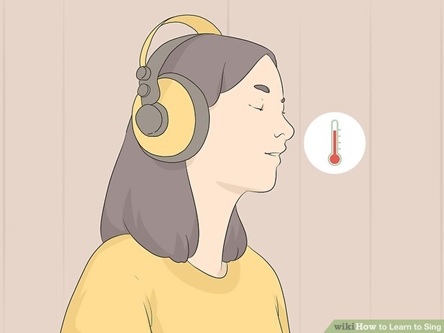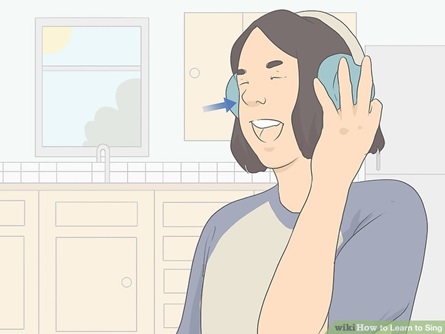If you want to learn how to sing, you need to practice daily. Singing lessons will help considerably, but if you can't take them, there are still ways you can learn on your own. It will take time, but you should begin to see results quickly, just by following these steps.

Begin with breathing exercises
Breathing exercises will allow you to better control the pitch and duration of your singing. It's no surprise: singers who can breathe deeply and consistently get better mileage out of their voice.
Practice opening your throat opening. Relax and open the jaw like a fish might out of water. Start flexing your facial muscles a little bit in between.
Begin by inhaling a couple deep breaths of air. Imagine that the air is really heavy as you breathe it in.
Let the breath fall below your belly button, into your diaphragm. Exhale and repeat several times.
Get a light pillow-feather and practice keeping it in the air, sort of like you're juggling a feather with your air stream. Gradually blow the feather really high up, and try keeping it there.
Don't let your chest collapse as you keep the feather in the air. Try to keep the air stream coming from your diaphragm.

warming up
Your vocal chords are a muscle, just like your biceps, and need to get stretched before you do any heavy lifting. You can warm up in a variety of ways.
Practice your major scales, starting with the middle C, moving down in half-steps before moving up. Don't push yourself before you're actually singing, and try to move slowly. As you continue to warm up, you'll get better at articulating all the notes in the scales.
The notes that you will hit start off as C-D-E-F-G-F-E-D-C and move either up or down one half-step for each new scale.

Find your range
Your range is the measure of pitches you can sing between your lowest and highest notes. Try any number of classical musical scales (you can easily find them with a simple online search) and see which notes on the bottom and which notes on the top are impossible for you to clearly sing.

Singing along to a song
Make sure the music is quiet and your voice is the real thing that the recorder picks up. After you're done singing, check if you are singing on key. Also check to see if you are:
Articulating words, especially vowels, clearly. In the beginning, over-articulate the words; really practice on getting them right.
Breathing correctly. Hard vocal parts will require you to stretch your voice out over a longer period of time. You'll need to be a strong breather for this.

Practice daily
Every day, practice your breathing exercises, warm-up routine, and recorded singing. Listen for parts that you don't hit with your voice and keep chugging. It could take several weeks of practice just to get a single song down pat.

Learn to use your nose
Good singing involves partial nasal placement; it is our body's soundboard. To avoid sounding nasal to others, however, your throat must be wide open with your tongue out of the way (slightly forward, touching the backs of bottom teeth when singing vowels). Nasality can often be heard in country singing and some R&B/Gospel, but can be unappealing to listen to.

Practice singing your vowels
Again, try to vocalize by using your diaphragm. The vowels, not the consonants, are what you really have to pay attention to.
Do not involve your neck muscles in your singing. Try to keep your neck upright but relaxed.
Practice keeping the back of your mouth open when you vocalize the vowels. Practice voicing the "ng" sound in training; the back of your mouth is closed. Now practice voicing the "ah" sound, like you're opening your mouth at the dentist. The back of your mouth is now open.

Practice hitting the high notes
High notes are the icing on top of the cake: not always necessary, but really wonderful when done right. You probably already know your range by now, so you also know which high notes you can hit and which ones you can't. Be sure to practice hitting the ones you can't yet reach. Practice will make perfect...
Envision jumping as you hit the high note. Perhaps you're jumping onto a trampoline, or maybe you're just jumping up into the air. Imagine hitting your highest point as you reach the high note. Take an adequate breath and keep your mouth open. Hitting a high note doesn't mean you need to increase how loudly you sing.

Continue your breathing exercises
Make breathing exercises an ongoing training opportunity. The better you get at breathing, the easier your vocal training will be.
Try this breathing exercise. where you breathe in and hiss out. Make sure your hiss is very even and consistent. The goal is consistency:
Breathe in for 4 seconds, and then hiss the same breathe out for 4 seconds.
Breathe in for 6 seconds, and hiss out for 12.
Breathe in for 2 seconds, and hiss out for 10.
Breathe in for 4 seconds, and hiss out for 16.
Breathe in for 2 seconds, and hiss out for 16.
Breathe in for 4 seconds, and hiss out for 20.
Breathe in for 2 seconds, and hiss out for 20.

Begin with breathing exercises
Breathing exercises will allow you to better control the pitch and duration of your singing. It's no surprise: singers who can breathe deeply and consistently get better mileage out of their voice.
Practice opening your throat opening. Relax and open the jaw like a fish might out of water. Start flexing your facial muscles a little bit in between.
Begin by inhaling a couple deep breaths of air. Imagine that the air is really heavy as you breathe it in.
Let the breath fall below your belly button, into your diaphragm. Exhale and repeat several times.
Get a light pillow-feather and practice keeping it in the air, sort of like you're juggling a feather with your air stream. Gradually blow the feather really high up, and try keeping it there.
Don't let your chest collapse as you keep the feather in the air. Try to keep the air stream coming from your diaphragm.

warming up
Your vocal chords are a muscle, just like your biceps, and need to get stretched before you do any heavy lifting. You can warm up in a variety of ways.
Practice your major scales, starting with the middle C, moving down in half-steps before moving up. Don't push yourself before you're actually singing, and try to move slowly. As you continue to warm up, you'll get better at articulating all the notes in the scales.
The notes that you will hit start off as C-D-E-F-G-F-E-D-C and move either up or down one half-step for each new scale.

Find your range
Your range is the measure of pitches you can sing between your lowest and highest notes. Try any number of classical musical scales (you can easily find them with a simple online search) and see which notes on the bottom and which notes on the top are impossible for you to clearly sing.

Singing along to a song
Make sure the music is quiet and your voice is the real thing that the recorder picks up. After you're done singing, check if you are singing on key. Also check to see if you are:
Articulating words, especially vowels, clearly. In the beginning, over-articulate the words; really practice on getting them right.
Breathing correctly. Hard vocal parts will require you to stretch your voice out over a longer period of time. You'll need to be a strong breather for this.

Practice daily
Every day, practice your breathing exercises, warm-up routine, and recorded singing. Listen for parts that you don't hit with your voice and keep chugging. It could take several weeks of practice just to get a single song down pat.

Learn to use your nose
Good singing involves partial nasal placement; it is our body's soundboard. To avoid sounding nasal to others, however, your throat must be wide open with your tongue out of the way (slightly forward, touching the backs of bottom teeth when singing vowels). Nasality can often be heard in country singing and some R&B/Gospel, but can be unappealing to listen to.

Practice singing your vowels
Again, try to vocalize by using your diaphragm. The vowels, not the consonants, are what you really have to pay attention to.
Do not involve your neck muscles in your singing. Try to keep your neck upright but relaxed.
Practice keeping the back of your mouth open when you vocalize the vowels. Practice voicing the "ng" sound in training; the back of your mouth is closed. Now practice voicing the "ah" sound, like you're opening your mouth at the dentist. The back of your mouth is now open.

Practice hitting the high notes
High notes are the icing on top of the cake: not always necessary, but really wonderful when done right. You probably already know your range by now, so you also know which high notes you can hit and which ones you can't. Be sure to practice hitting the ones you can't yet reach. Practice will make perfect...
Envision jumping as you hit the high note. Perhaps you're jumping onto a trampoline, or maybe you're just jumping up into the air. Imagine hitting your highest point as you reach the high note. Take an adequate breath and keep your mouth open. Hitting a high note doesn't mean you need to increase how loudly you sing.

Continue your breathing exercises
Make breathing exercises an ongoing training opportunity. The better you get at breathing, the easier your vocal training will be.
Try this breathing exercise. where you breathe in and hiss out. Make sure your hiss is very even and consistent. The goal is consistency:
Breathe in for 4 seconds, and then hiss the same breathe out for 4 seconds.
Breathe in for 6 seconds, and hiss out for 12.
Breathe in for 2 seconds, and hiss out for 10.
Breathe in for 4 seconds, and hiss out for 16.
Breathe in for 2 seconds, and hiss out for 16.
Breathe in for 4 seconds, and hiss out for 20.
Breathe in for 2 seconds, and hiss out for 20.
Practice
If you want to learn how to sing, you need to practice daily. Singing lessons will help considerably, .click here for video
starting with the middle C, moving down in half-steps before moving up. Don't push yourself before you're actually singing, and try to move slowly. As you continue to warm up, you'll get better at articulating all the notes in the scales.Scale
